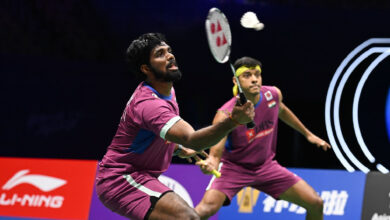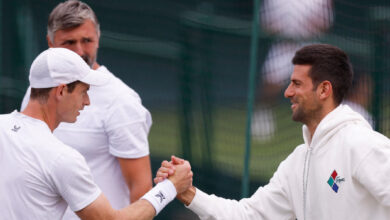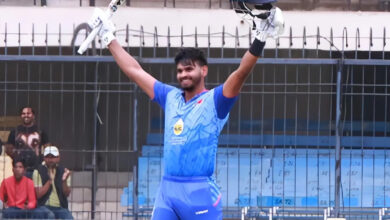World Cup: A peek behind why New Zealand keep sparkling at ICC events and produce Olympians in numbers | Cricket-world-cup News

Someone from the New Zealand squad poked Daryl Mitchell to look towards his right. The Mumbai sun had set, New Zealand were just about to begin their warm-up as Mitchell looked up and stared at the recently installed Sachin Tendulkar statue. Mitchell stared and soon other New Zealand players also craned their necks and peered at the Indian cricketing deity.
In New Zealand, cricketers don’t enjoy demi-god status, that honour is reserved for the rug players. Mitchell would be aware of this. His father has been a celebrated rug coach in New Zealand, England, Australia, and South Africa.
Follow all the action from the Cricket World Cup 2023 on our special World Cup section. You can also find the latest stats, like the top scorer and the highest wicket-taker of the current edition, upcoming World Cup fixtures and the points table on the site.
However, New Zealand cricketers have been quietly consent at the World Cup and other big tournaments. To state the obvious they always punch beyond their weight and are title contenders at most ICC events. It begs a question: How does a small nation like New Zealand produce world-class cricketers, along with the many Olympians and world beaters in other sports?
Nigel Muir, who quit as CEO of Sport Tasman after 13 long years in 2022, had the answer. It was during the 2015 World Cup while at the small seaside rural town Nelson, right in the centre of the country, Muir had shared the secret. Amused the question, he pointed his finger out to declare: “You tell me, how you can’t get out there and play sport in this setting?”. Nuir had told this newspaper that Nelson, the small sun-wrapped region, had produced at least 24 Olympians.
Rural New Zealand is where the country unwraps its natural splendour and provides a unique window to its sporting soul. Adjacent to Nelson happens to be the Tasman region. Both have a population of around 50,000. Sandwiched between Nelson and Tasman is Saxton Oval, a large open park with facilities for football, athletics, cricket and several other sports. On one side, Richmond hills envelop the region and across the aisle the Tasman sea shimmered. Muir’s finger was pointing at all these glorious open spaces.
According to Muir, community building was the central philosophy of New Zealand’s sporting ecosystem. Consider this stat from Muir: One out of three New Zealanders, across the country are involved in some sort of sports voluntary activity. Country’s leading sportspersons regularly pitch in with free coaching or a motivational talk. Others could chip in with cleaning the dishes at a sports meet, preparing the ground or just driving the kids to sporting facilities. Everyone has a personal stake in the entire enterprise: Parents, teachers, kids and senior citizens. As for facilitators like Muir, they hold this interesting tapestry together.
He then pointed to a poster plastered in the adminration office at the Saxton Oval cricket ground. Happy smiling kids, hundreds of them, are captured in a festival atmosphere on the beach. A sporting event has just finished the look of the things and all have a blissful look as the camera swoops on them from the top. The thing is no one knows who won, who lost. “Deliberately done. Look you might be a great potential sportsman but we here are looking out for the others. There might be 1 per cent who can probably have a career in sports but what about the rest? What we are trying to do is use sports to produce people who are happier and turn out to be good human beings. What’s the point of life if you don’t do that?”.
It’s an interesting philosophy but does it also mean it could hurt the chances of producing top athletes? This line of thought is very different from their neighbours and sporting arch-rivals Australia. The Aussies love winners, they stress on success. “The amount of money Australia puts into producing high-performance athletes is a lot more than us,” Muir said. “It’s an interesting thing and something that is catching up here as well. The right thing to do is find the right balance but you know it does get difficult.”Most Read
1
Tiger 3 box office collection day 1: Salman Khan gets biggest opening of his career as film braves Diwali day to record Rs 94 cr earning
2
Tiger 3 box office collection Day 1 early reports: Salman Khan actioner eyes biggest Diwali day in Bollywood hory
See More
Another interesting development has occurred with respect to cricket. During the 2015 World Cup, a local newspaper ran a story about children’s participation in official school cricket with a stat: ‘The number of secondary school-aged children playing cricket has dropped from 17,794 in 2000 to 9937 last year.’
But everywhere one went during that World Cup, Brendon McCullum mania was on; his team’s infectious style of play had caught the attention and kids were out there playing cricket in the parks. And then their glorious run in the 2019 World Cup occurred. NZ Cricket put up a stat the other day: the number of secondary school players increased 513 (2%) to 21,974. It seems to be near an all-time high.
The Black Caps might not be as popular as the All Blacks but they remain perpetual title contenders. They play an entertaining brand of cricket that continues to inspire the world and also motivate the kids in New Zealand to take up the sport in those gorgeous open spaces.







